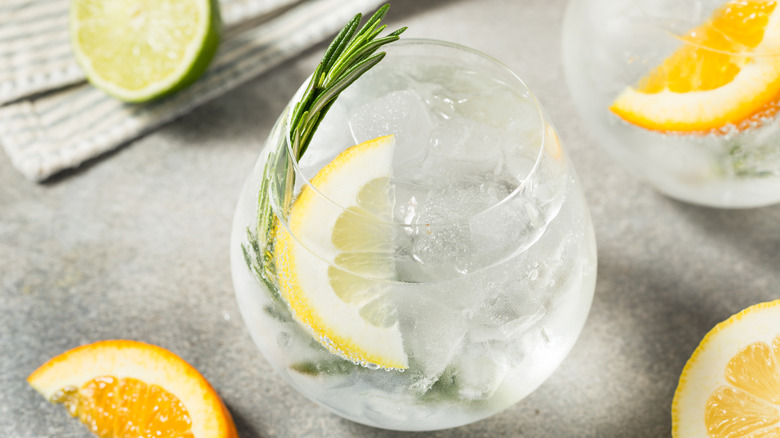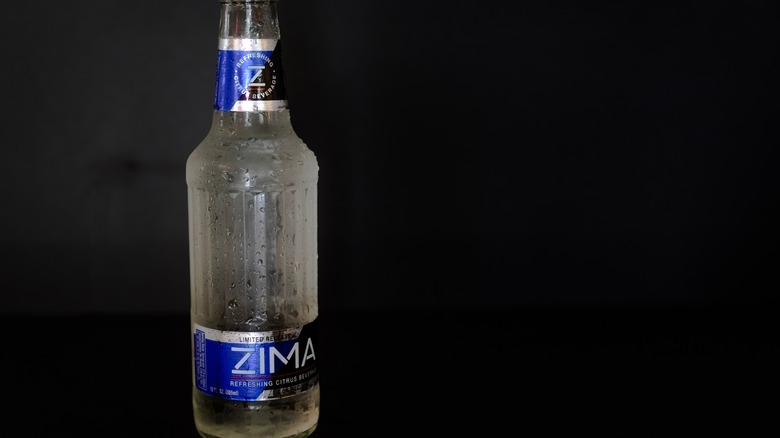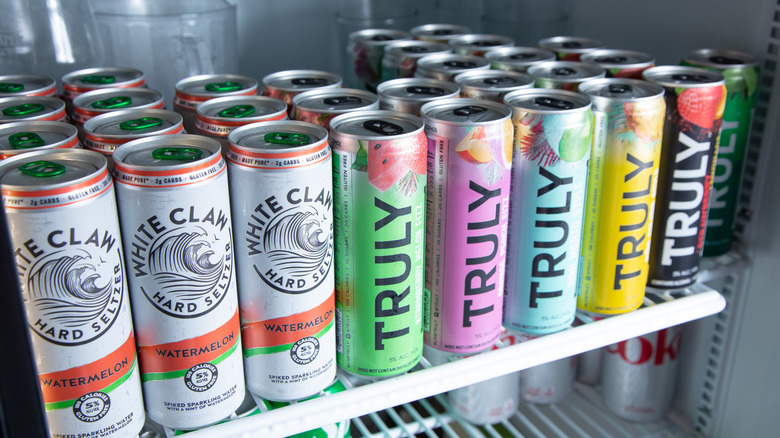The Brewing Company That Brought Hard Seltzers Into The World
Hard seltzer has gone from being a boozy trend to a beloved bar standard. Be it the ever-present White Claw, Truly Hard Seltzer, or the more boutique brands like Ranch Water, the bubbly alcoholic drink that seemed like it splashed onto shelves in 2019 became a quick crowd favorite. According to Nielsen data, the sale of hard seltzers increased 73% at bars and restaurants between the spring and fall of 2019 alone. Sales continued to grow in the US, and the market hit $4.1 billion in 2020.
However, hard seltzer was not newly dreamed up in 2019, but actually several decades earlier. In 1993, Coors Brewing Company launched Zima, a clear bubbly lemon-lime malt-based beverage, similar to today's hard seltzers. The drink was advertised as a beer alternative to young people, and became a massive hit, selling 1.3 million barrels in 1994. Zima's once massive popularity waned through the 90s and early 2000s, and the company cut U.S. production in 2008. (Fun fact, the malt beverage product expanded to Japan in 1996 and never went out of style, it's still available there today.)
But all trends come back into style eventually. In 2013, a new company called SpikedSeltzer crafted a drink that was an aim at a boozier LaCroix. In 2016, they were acquired by Anheuser-Busch, and hard seltzer giants White Claw and Truly came onto the scene, completely upending the market. Even the beloved Zima was briefly resurrected in 2017, and put back on U.S. shelves to some brief success.
The cultural phenomenon that was Zima
Zima was a part of the cultural zeitgeist in the 90s. Both its clear color and zippy name were designed to appeal to 90s consumers. A company executive told the Miami New Times that Coors chose the name Zima, the Russian word for winter, with the hope of conjuring thoughts of snow-like cool refreshment. The drink's pure clear appearance also coincided with a larger trend in the early 90s of companies producing novel diaphanous products — Crystal Pepsi, and TaB Clear were briefly on the market at just about the same time.
According to Ranker, Coors spent $38 million on marketing Zima in its launch. The company needed all that dough to explain the novel concept of a "clearmalt" drink, and to reach young consumers. The frequent television commercials often featured a spokesman who switched all his S's with Z's such that Zima was lauded as "zomething different."
Despite Zima's big splash onto the scene, it was often a point of derision. Sales fell quickly after its debut, and late night host David Letterman regularly roasted the drink in his nightly Top Ten lists. But nostalgia for Zima (or for the 90s more generally) keeps the beverage's name alive. When it was briefly resurrected in 2017, Coors sold out two thirds of its inventory in just four weeks.
But what is hard seltzer really?
Hard seltzers have evolved quite a bit since the days of Zima, and they are made with a completely different process. To make the clearmalt beverage, Coors would filter its lower-grade lagers through charcoal processing, which removed the color and flavor of beer. Then, lemon-lime flavoring was added.
Today's hard seltzers, on the other hand, have a base of sugar, water, and yeast that ferment to create an alcoholic base. This base is then filtered or "scrubbed" to remove unwanted flavors. Natural or artificial flavorings are added, and finally the beverage is carbonated to create the final hard seltzer beverage. This is why hard seltzers come in such a wide array of flavors and tastes — by creating the base and then adding the flavor, producers have incredible freedom in combining and creating new varieties.
If you find yourself longing for a cool sip of Zima in the present day, your best bet is likely a lemon-lime flavor of the many hard seltzer options available today, or just a standard seltzer water with a splash of lemon and gin. Make sure you don't accidentally reach for a club soda or sparkling water by mistake, you'll have a different experience.



